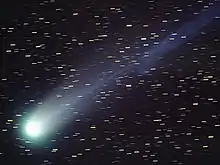| Discovery[1] | |
|---|---|
| Discovered by | John Edward Mellish |
| Discovery date | 19 March 1917 |
| Designations | |
| 1917a, 1917I | |
| Orbital characteristics[2] | |
| Epoch | 1917-Mar-31.0 |
| Observation arc | 38 days |
| Aphelion | 54.61 AU |
| Perihelion | 0.190 AU |
| Semi-major axis | 27.40 AU |
| Eccentricity | 0.9931 |
| Orbital period | 143 years |
| Inclination | 32.69° |
| 88.67° | |
| Argument of periapsis | 121.31° |
| Last perihelion | 11 April 1917 |
| Next perihelion | ~2060 |
| Earth MOID | 0.062 AU |
| Jupiter MOID | 1.53 AU |
| Comet total magnitude (M1) | 11 |
C/1917 F1 (Mellish), also known as Comet 1917Ι and 1917a, is a Halley-type comet discovered by John E. Mellish on 19 March 1917. The comet has an orbital period of 143 years and last passed perihelion on 11 April 1917. It is the parent body of the December Monocerotids and has also been suggested to be the parent body of daytime kappa Leonids,[3] April ρ-Cygnids, November Orionids, and Canis-Minorids meteor showers.[4][5]
The comet upon discovery was in the constellation of Aries and it was located low in the sky and was very condensed. On 23 March a short tail was reported.[1] After perihelion, on 11 April, the comet nucleus was reported to be very bright on 14 April, with a report mentioning it was brighter than Venus,[6] while it developed a tail that measured 10 degrees in length. The comet faded quickly and by the end of April it was of 5th magnitude and the comet's tail was three degrees long.[7]
The comet has an orbital period of about 145 years, and thus fits the definition of Halley type comets, which have an orbital period between 20 and 200 years. Its orbital period is similar to comet Swift-Tuttle, the parent body of the Perseids. The comet has a relatively small perihelion distance, about 0.19 AU (28 million km; 18 million mi).[8] The minimum orbit intersection distance with Earth is 0.06 AU (9.0 million km; 5.6 million mi) while the same distance from Venus is 0.0084 AU (1.26 million km; 0.78 million mi), and could create a meteor shower in Venus.[9]
In 1979, Ichiro Hasegawa tentatively identified a comet observed in December 193 CE as a previous apparition of C/1917 F1 (Mellish).[10]
References
- 1 2 "New Comet a 1917 (Mellish)". Popular Astronomy. 25: 264–265. 1 January 1917. ISSN 0197-7482.
- ↑ "Small-Body Database Lookup: C/1917 F1 (Mellish)". ssd.jpl.nasa.gov.
- ↑ "00212 KLE Daytime kappa Leonids". www.ta3.sk. IAU. Retrieved 13 May 2023.
- ↑ Neslušan, L.; Hajduková, M. (June 2014). "The meteor-shower complex of comet C/1917 F1 (Mellish)". Astronomy & Astrophysics. 566: A33. doi:10.1051/0004-6361/201423382.
- ↑ Vereš, P.; Kornoš, L.; Tóth, J. (21 March 2011). "Meteor showers of comet C/1917 F1 Mellish". Monthly Notices of the Royal Astronomical Society. 412 (1): 511–521. arXiv:1010.5733. doi:10.1111/j.1365-2966.2010.17923.x.
- ↑ Baldwin, J. M. (1 January 1918). "Observations de la comète 1917 a Meìlish". Journal des Observateurs. 2: 37. ISSN 0368-3389.
- ↑ Wood, H. E. (1 July 1917). "Orbit of Mellish's Comet". The Observatory. 40: 273–274. ISSN 0029-7704.
- ↑ Neslušan, L.; Vaubaillon, J.; Hajduková, M. (May 2016). "A study to improve the past orbit of comet C/1917 F1 (Mellish) on the basis of its observed meteor showers". Astronomy & Astrophysics. 589: A100. doi:10.1051/0004-6361/201527526.
- ↑ Christou, A. A. (March 2010). "Annual meteor showers at Venus and Mars: lessons from the Earth". Monthly Notices of the Royal Astronomical Society. 402 (4): 2759–2770. doi:10.1111/j.1365-2966.2009.16097.x.
- ↑ Hasegawa, I. (1 January 1979). "Orbits of Ancient and Medieval Comets". Publications of the Astronomical Society of Japan. 31: 257–270. ISSN 0004-6264.
External links
- C/1917 F1 at the JPL Small-Body Database

.png.webp)